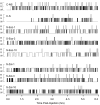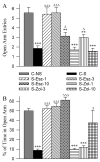Effects of eszopiclone and zolpidem on sleep-wake behavior, anxiety-like behavior and contextual memory in rats
- PMID: 20153782
- PMCID: PMC2844486
- DOI: 10.1016/j.bbr.2010.02.018
Effects of eszopiclone and zolpidem on sleep-wake behavior, anxiety-like behavior and contextual memory in rats
Abstract
At present, eszopiclone and zolpidem are the most commonly prescribed drugs for treating insomnia. Despite the established relationship between sleep disturbance and anxiety, it remains unknown whether targeted treatment for insomnia may affect acute anxiety. Therefore, the objective of this study was to examine the effects of three different doses (1, 3, and 10mg/kg) of eszopiclone and zolpidem on the states of sleep and wakefulness, levels of anxiety-like behavior, and long-term contextual memory in footshock-induced anxious rats. The results of this study demonstrated that the administration of eszopiclone and zolpidem both were equally effective in attenuating footshock stressor-induced suppression of slow-wave sleep (SWS). The administration of eszopiclone at 1mg/kg or zolpidem at 1 and 3mg/kg doses showed a tendency for attenuating stressor-induced suppression of REM sleep. However, the REM sleep attenuating effects of these drugs disappeared when they were administered at higher doses. The administration of eszopiclone at 3 and 10mg/kg doses and zolpidem at all three doses reduced the power of electroencephalographic theta band frequencies during wakefulness. In addition, the administration of eszopiclone at 1 and 3mg/kg doses suppressed stressor-induced anxiety-like behavior. The administration of zolpidem at 1, 3, or 10mg/kg doses was not effective in attenuating stressor-induced anxiety-like behavior. Contextual memory after administration of eszopiclone at 1mg/kg dose had no effects, but was reduced significantly with increased dosage. Contextual memory after administration of zolpidem, at all three doses, was severely disrupted. The results of this study suggest that eszopiclone at a low dose could be used effectively to control anxiety and anxiety-induced insomnia.
Figures










References
-
- Benavides J, Peny B, Durand A, Arbilla S, Scatton B. Comparative in vivo and in vitro regional selectivity of central omega (benzodiazepine) site ligands in inhibiting [3H]flumazenil binding in the rat central nervous system. J Pharmacol Exp Ther. 1992;263:884–896. - PubMed
-
- Bertoglio LJ, Carobrez AP. Previous maze experience required to increase open arms avoidance in rats submitted to the elevated plus-maze model of anxiety. Behav Brain Res. 2000;108:197–203. - PubMed

